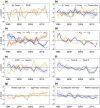Decoupled trophic responses to long-term recovery from acidification and associated browning in lakes
- PMID: 30698903
- PMCID: PMC6850094
- DOI: 10.1111/gcb.14580
Decoupled trophic responses to long-term recovery from acidification and associated browning in lakes
Abstract
Increases in the concentration of dissolved organic matter (DOM) have been documented in many inland waters in recent decades, a process known as "browning". Previous studies have often used space-for-time substitution to examine the direct consequences of increased DOM on lake ecosystems. However, browning often occurs concomitant with other ecologically important water chemistry changes that may interact with or overwhelm any potential ecological response to browning itself. Here we examine a long-term (~20 year) dataset of 28 lakes in the Adirondack Park, New York, USA, that have undergone strong browning in response to recovery from acidification. With these data, we explored how primary producer and zooplankton consumer populations changed during this time and what physical and chemical changes best predicted these long-term ecosystem changes. Our results indicate that changes in primary producers are likely driven by reduced water clarity due to browning, independent of changes in nutrients, counter to previously hypothesized primary producer response to browning. In contrast, declines in calcium concomitant with browning play an important role in driving long-term declines in zooplankton biomass. Our results indicate that responses to browning at different trophic levels are decoupled from one another. Concomitant chemical changes have important implications for our understanding of the response of aquatic ecosystems to browning.
Keywords: Adirondack Mountains; acidification; aquatic; calcium; dissolved organic matter; long-term trends.
© 2019 The Authors. Global Change Biology Published by John Wiley & Sons Ltd.
Figures






References
-
- Arnott, S. E. , Azan, S. E. , & Ross, A. J. (2017). Calcium decline reduces population growth rates of zooplankton in field mesocosms. Canadian Journal of Zoology, 95, 323–333. 10.1139/cjz-2016-0105 - DOI
-
- Ashforth, D. , & Yan, N. D. (2008). The interactive effects of calcium concentration and temperature on the survival and reproduction of Daphnia pulex at high and low food concentrations. Limnology and Oceanography, 53, 420–432.
-
- Azan, S. S. E. , & Arnott, S. E. (2017). The impact of calcium decline on population growth rates of crustacean zooplankton in Canadian Shield lakes. Limnology and Oceanography.
Publication types
MeSH terms
Substances
LinkOut - more resources
Full Text Sources

